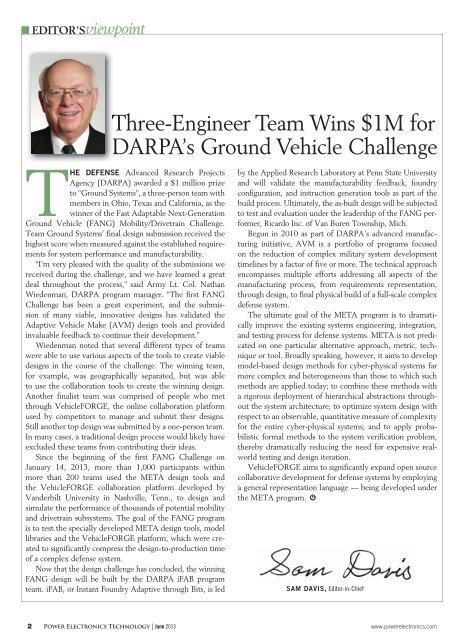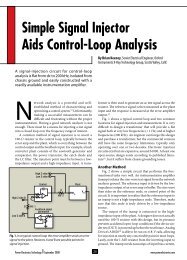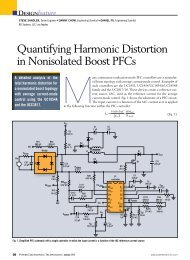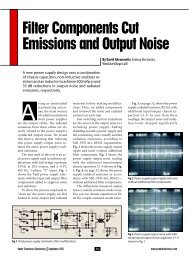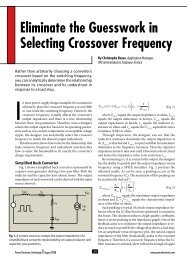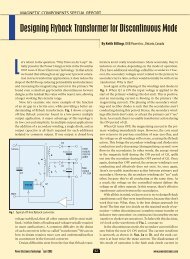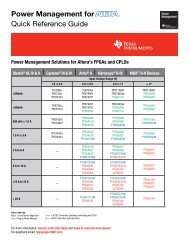Power Electronics Technology
Power Electronics Technology
Power Electronics Technology
Create successful ePaper yourself
Turn your PDF publications into a flip-book with our unique Google optimized e-Paper software.
EDITOR’Sviewpoint<br />
Three-Engineer Team Wins $1M for<br />
DARPA’s Ground Vehicle Challenge<br />
THE DEFENSE Advanced Research Projects<br />
Agency (DARPA) awarded a $1 million prize<br />
to “Ground Systems”, a three-person team with<br />
members in Ohio, Texas and California, as the<br />
winner of the Fast Adaptable Next-Generation<br />
Ground Vehicle (FANG) Mobility/Drivetrain Challenge.<br />
Team Ground Systems’ final design submission received the<br />
highest score when measured against the established requirements<br />
for system performance and manufacturability.<br />
“I’m very pleased with the quality of the submissions we<br />
received during the challenge, and we have learned a great<br />
deal throughout the process,” said Army Lt. Col. Nathan<br />
Wiedenman, DARPA program manager. “The first FANG<br />
Challenge has been a great experiment, and the submission<br />
of many viable, innovative designs has validated the<br />
Adaptive Vehicle Make (AVM) design tools and provided<br />
invaluable feedback to continue their development.”<br />
Wiedenman noted that several different types of teams<br />
were able to use various aspects of the tools to create viable<br />
designs in the course of the challenge. The winning team,<br />
for example, was geographically separated, but was able<br />
to use the collaboration tools to create the winning design.<br />
Another finalist team was comprised of people who met<br />
through VehicleFORGE, the online collaboration platform<br />
used by competitors to manage and submit their designs.<br />
Still another top design was submitted by a one-person team.<br />
In many cases, a traditional design process would likely have<br />
excluded these teams from contributing their ideas.<br />
Since the beginning of the first FANG Challenge on<br />
January 14, 2013, more than 1,000 participants within<br />
more than 200 teams used the META design tools and<br />
the VehicleFORGE collaboration platform developed by<br />
Vanderbilt University in Nashville, Tenn., to design and<br />
simulate the performance of thousands of potential mobility<br />
and drivetrain subsystems. The goal of the FANG program<br />
is to test the specially developed META design tools, model<br />
libraries and the VehicleFORGE platform, which were created<br />
to significantly compress the design-to-production time<br />
of a complex defense system.<br />
Now that the design challenge has concluded, the winning<br />
FANG design will be built by the DARPA iFAB program<br />
team. iFAB, or Instant Foundry Adaptive through Bits, is led<br />
by the Applied Research Laboratory at Penn State University<br />
and will validate the manufacturability feedback, foundry<br />
configuration, and instruction generation tools as part of the<br />
build process. Ultimately, the as-built design will be subjected<br />
to test and evaluation under the leadership of the FANG performer,<br />
Ricardo Inc. of Van Buren Township, Mich.<br />
Begun in 2010 as part of DARPA’s advanced manufacturing<br />
initiative, AVM is a portfolio of programs focused<br />
on the reduction of complex military system development<br />
timelines by a factor of five or more. The technical approach<br />
encompasses multiple efforts addressing all aspects of the<br />
manufacturing process, from requirements representation,<br />
through design, to final physical build of a full-scale complex<br />
defense system.<br />
The ultimate goal of the META program is to dramatically<br />
improve the existing systems engineering, integration,<br />
and testing process for defense systems. META is not predicated<br />
on one particular alternative approach, metric, technique<br />
or tool. Broadly speaking, however, it aims to develop<br />
model-based design methods for cyber-physical systems far<br />
more complex and heterogeneous than those to which such<br />
methods are applied today; to combine these methods with<br />
a rigorous deployment of hierarchical abstractions throughout<br />
the system architecture; to optimize system design with<br />
respect to an observable, quantitative measure of complexity<br />
for the entire cyber-physical systems; and to apply probabilistic<br />
formal methods to the system verification problem,<br />
thereby dramatically reducing the need for expensive realworld<br />
testing and design iteration.<br />
VehicleFORGE aims to significantly expand open source<br />
collaborative development for defense systems by employing<br />
a general representation language — being developed under<br />
the META program.<br />
SAM DAVIS, Editor-in-Chief<br />
2 <strong>Power</strong> <strong>Electronics</strong> <strong>Technology</strong> | June 2013 www.powerelectronics.com


